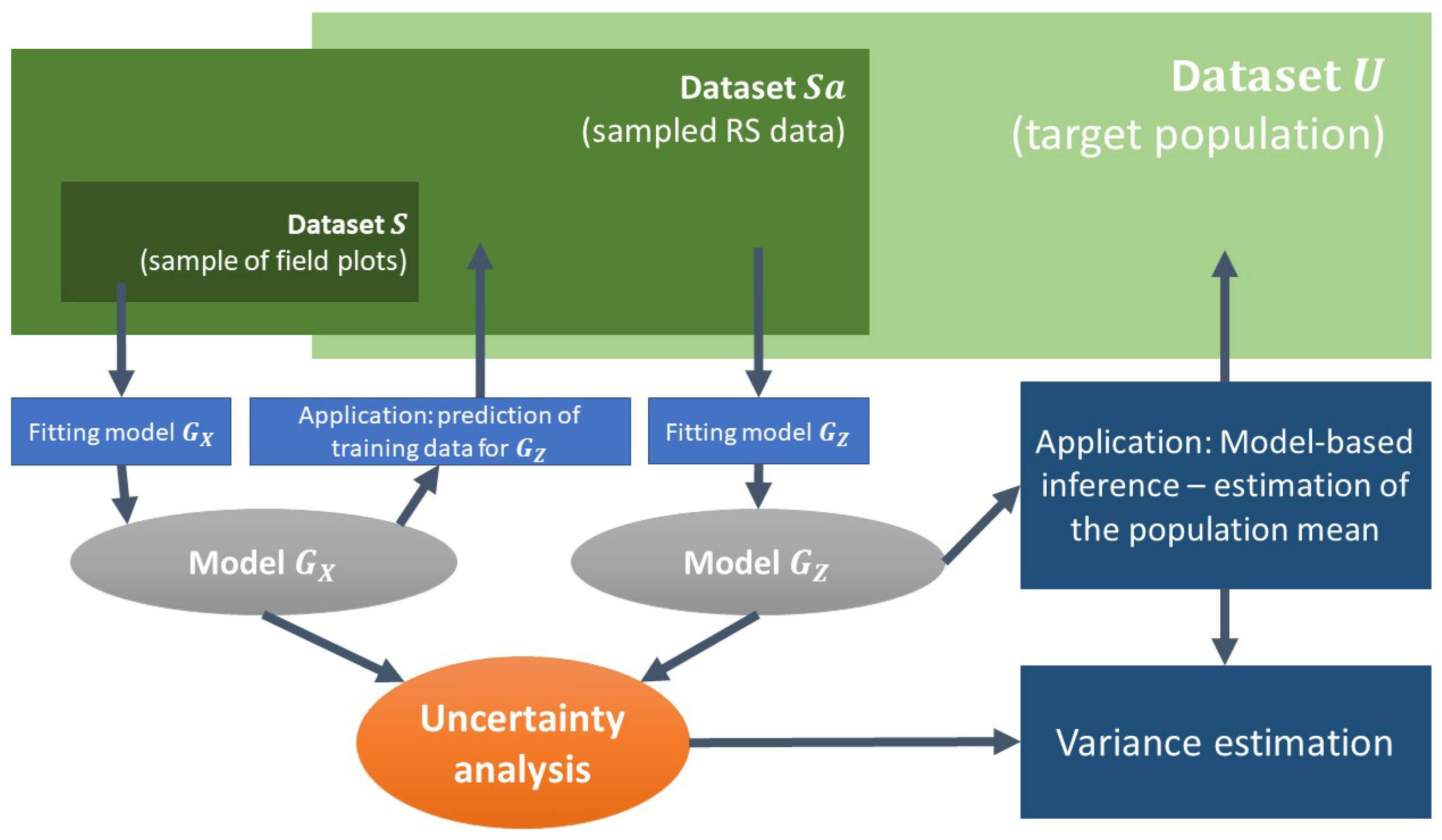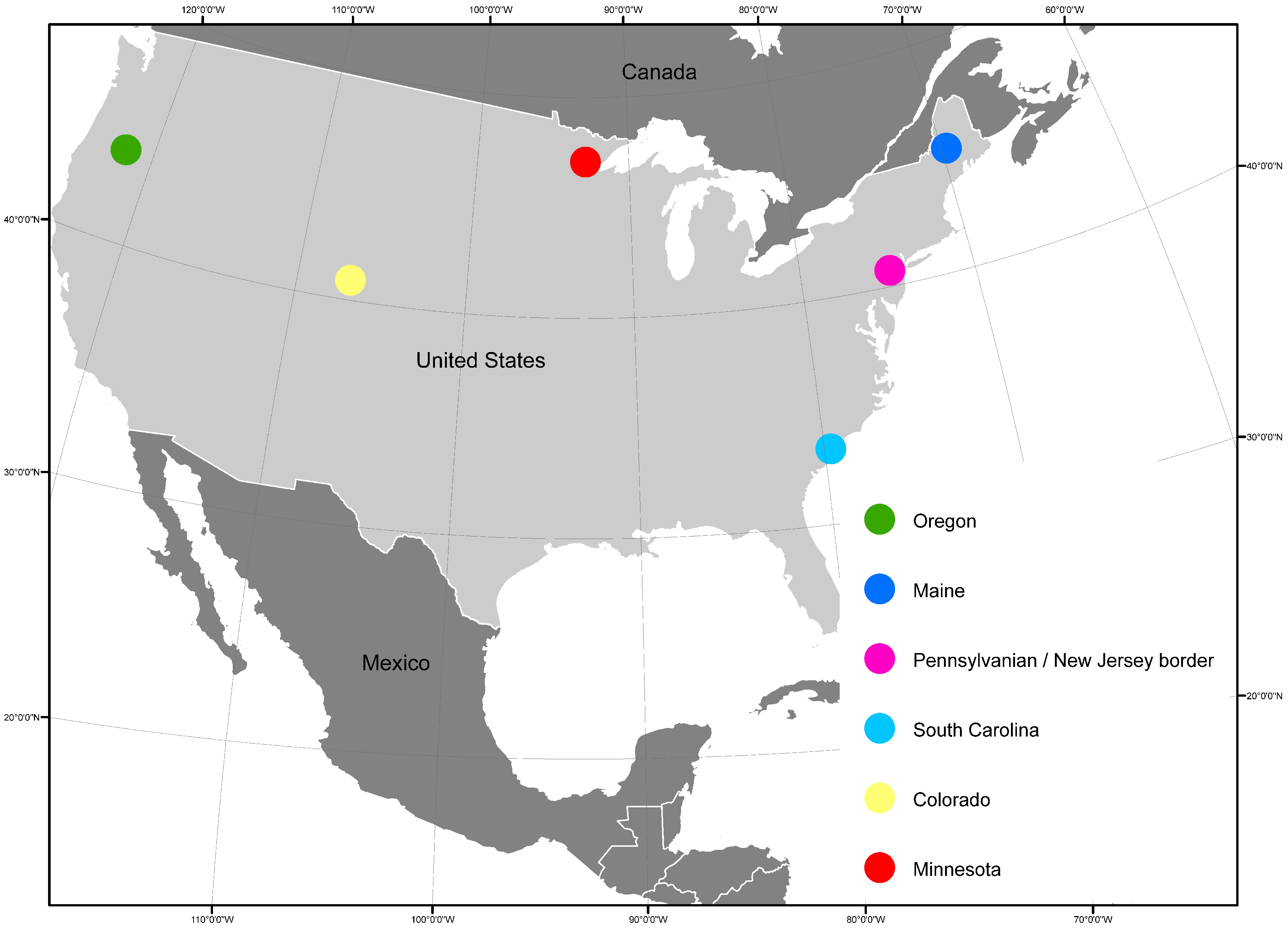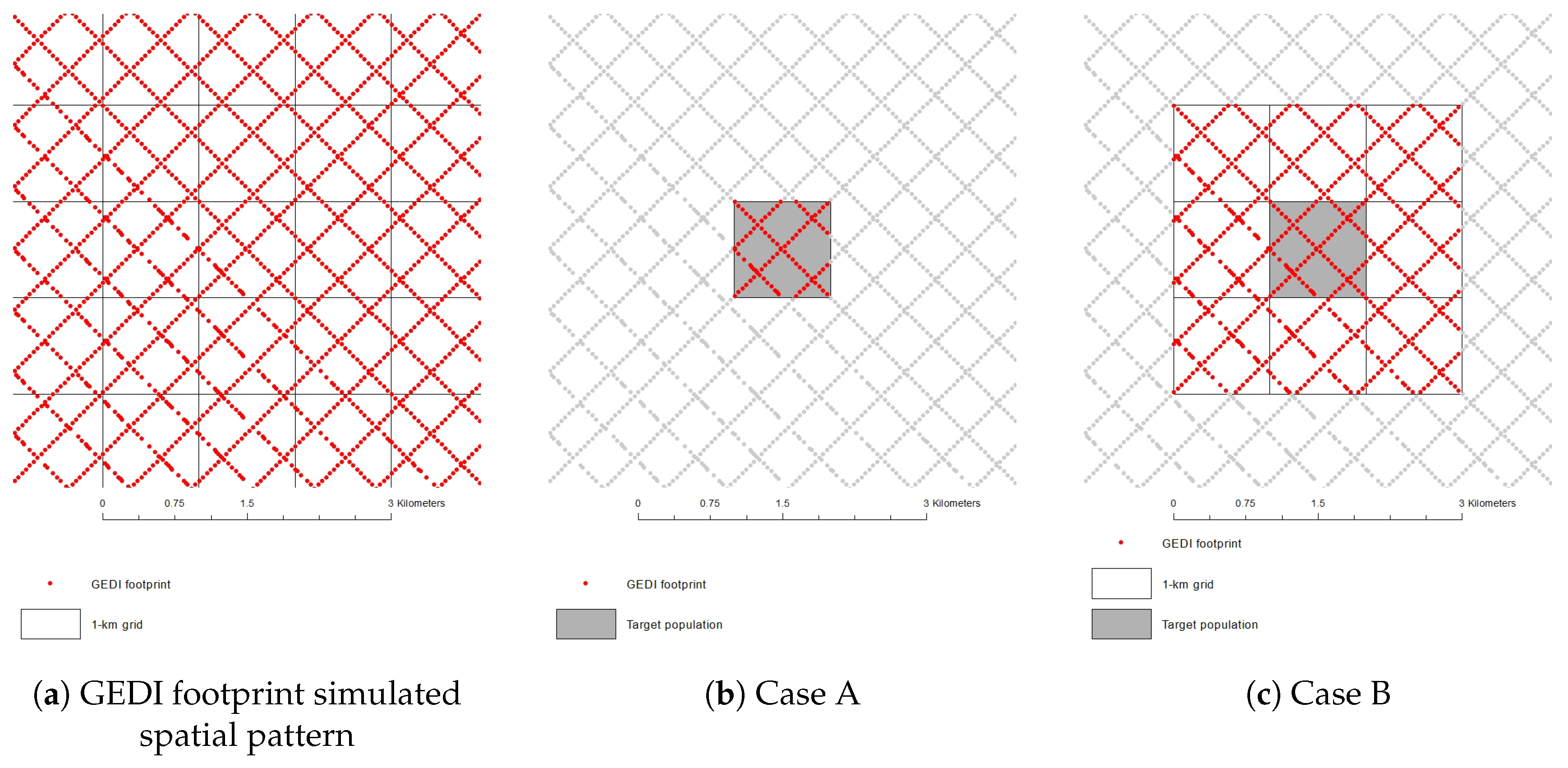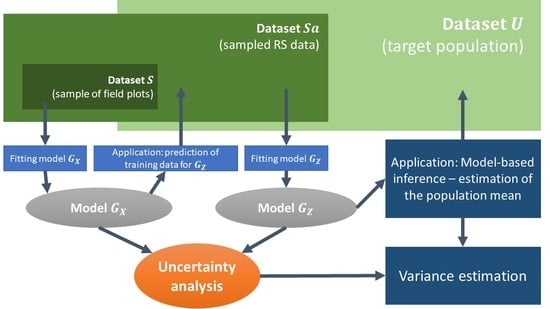Generalized Hierarchical Model-Based Estimation for Aboveground Biomass Assessment Using GEDI and Landsat Data
Abstract
1. Introduction
2. Methods
2.1. Overview
2.2. Generalized Hierarchical Model-Based Estimation (GHMB)
- The first dataset, denoted S, contains a sample of field data for which sampled RS data are also available. The dataset is used for estimating the model parameters . Each estimator based on this set is given the subscript S; the data S comprise n field observations.
- The second dataset, denoted , contains the enlarged sample of RS data and the corresponding RS data from the wall-to-wall dataset. It is used for estimating the model parameters , and any estimator based on this set has the subscript ; the data comprise M sampled RS observations.
- The third dataset contains the wall-to-wall RS data for the entire target population, U. The target population U comprises N population elements.
- with clustered data structure, and are block-diagonal matrices, where the blocks correspond to the clusters;
- under spatial autocorrelation, the matrices’ off-diagonal elements, corresponding to covariances between errors, are non-zero;
2.3. Reference Methods for Comparison
2.3.1. Generalized Two-Stage Model-Based Estimation (GTSMB)
2.3.2. Hybrid Estimation
2.3.3. Conventional Model-Based Inference (MB)
3. Material
3.1. Reference Data
3.1.1. Simulated GEDI Data
3.1.2. Landsat 7 ETM+ Data
3.1.3. Field Data
3.2. Simulated Populations
3.3. Regression Modeling
3.4. Evaluation Criteria
4. Results
Sources of Uncertainty for the GHMB and Hybrid Estimation Methods
5. Discussion
- One important issue is that all the case study data were simulated, based on sparse samples of reference data. The simulations are simplified generalizations of the real world, that leave out many important issues that must be handled in practical surveys, such as delineating forests from non-forest land [42]. In practical applications, land-use maps need to be applied to delineate forests before the GHMB method is employed.
- Another important restriction of the present study is that the results are based on estimates from a small number of iterations. A future expanded study should be based on Monte Carlo simulations of both the populations and the sampling from these populations, as a basis for empirical evaluation of the proposed estimators. Another method for simulating the multivariate variable in Equation (23) might be applied to demonstrate explicitly abilities of the proposed estimators.
- Further, future studies on this subject should also deal with the details of how to estimate the correlation matrices of model errors that are required for the GLS regression; in this article these details are only briefly addressed. One of the solutions to this problem could be iterative re-weighted least squares regression methods, such methods are often applied in geostatistical approaches.
- The current GHMB estimator is derived under the assumption that the target population is large, i.e., so that the population mean is at least approximately equal to the superpopulation mean. Modifications of the GHMB estimators for small-area estimation should be addressed in a potential future study.
- In the current study we assumed that the regression models involved in the AGB assessment by means of GEDI and Landsat data are linear. However, in reality the relationship between AGB (or growing stock volume) and height-like measures tends to be nonlinear e.g., [23]. A further elaboration of the GHMB method for nonlinear models would be needed to handle such cases.
- Lastly, the performance of GHMB method in comparison to other methods should be analyzed as a basis for making recommendations on what method is appropriate under different conditions.
6. Conclusions
Author Contributions
Funding
Acknowledgments
Conflicts of Interest
Abbreviations
| AGB | AboveGround Biomass |
| GEDI | Global Ecosystem Dynamics Investigation |
| GHMB | Generalized Hierarchical Model-Based |
| GLS | Generalized Lest Squares |
| GTSMB | Generalized Two-Stage Model-Based |
| Landsat 7 ETM+ | Landsat 7 Enhanced Thematic Mapper Plus |
| LiDAR | Light Detection And Ranging |
| MB | Model-Based |
| NFI | National Forest Inventory |
| PALS | Portable Airborne Laser System |
| RS | Remote Sensing |
| UNFCCC | United Nations’ Framework Convention on Climate Change |
Appendix A. Generalized Hierarchical Model-Based Estimators
Appendix B. A Comparison between Expectations and Variance Estimators of the Two Methods: GHMB and GTSMB
Appendix C. Field and LiDAR Data Collection Methods
References
- UNFCCC. United Nations Framework Convention on Climate Change. Available online: http://unfccc.int/resource/convkp/kpeng.html (accessed on 5 September 2017).
- Europe, F.; Unece, F. State of Europe’s Forests 2011. Available online: https://library.wmo.int/index.php?lvl=notice_display&id=5268#.W_PPmcTNWUm (accessed on 5 September 2017).
- Wulder, M.A.; White, J.C.; Nelson, R.F.; Næsset, E.; Ørka, H.O.; Coops, N.C.; Hilker, T.; Bater, C.W.; Gobakken, T. Lidar sampling for large-area forest characterization: A review. Remote Sens. Environ. 2012, 121, 196–209. [Google Scholar] [CrossRef]
- McRoberts, R.E.; Wendt, D.G.; Nelson, M.D.; Hansen, M.H. Using a land cover classification based on satellite imagery to improve the precision of forest inventory area estimates. Remote Sens. Environ. 2002, 81, 36–44. [Google Scholar] [CrossRef]
- Saarela, S.; Grafström, A.; Ståhl, G.; Kangas, A.; Holopainen, M.; Tuominen, S.; Nordkvist, K.; Hyyppä, J. Model-assisted estimation of growing stock volume using different combinations of LiDAR and Landsat data as auxiliary information. Remote Sens. Environ. 2015, 158, 431–440. [Google Scholar] [CrossRef]
- Grafström, A.; Schnell, S.; Saarela, S.; Hubbell, S.; Condit, R. The continuous population approach to forest inventories and use of information in the design. Environmetrics 2017, 28. [Google Scholar] [CrossRef]
- Matérn, B. Spatial Variation: Stochastic models and their applictation to some problems in forest surveys and other sampling investiagtions. Meddelanden från Statens Skogsforskningsinstitut 1960, 49, 144. [Google Scholar]
- Gregoire, T.G. Design-based and model-based inference in survey sampling: Appreciating the difference. Can. J. For. Res. 1998, 28, 1429–1447. [Google Scholar] [CrossRef]
- McRoberts, R.E.; Magnussen, S.; Tomppo, E.O.; Chirici, G. Parametric, bootstrap, and jackknife variance estimators for the k-Nearest Neighbors technique with illustrations using forest inventory and satellite image data. Remote Sens. Environ. 2011, 115, 3165–3174. [Google Scholar] [CrossRef]
- Särndal, C.E.; Swensson, B.; Wretman, J.H. Model Assisted Survey Sampling; Springer: New York, NY, USA, 1992; p. 716. [Google Scholar]
- Gregoire, T.G.; Ståhl, G.; Næsset, E.; Gobakken, T.; Nelson, R.; Holm, S. Model-assisted estimation of biomass in a LiDAR sample survey in Hedmark County, Norway. Can. J. For. Res. 2011, 41, 83–95. [Google Scholar] [CrossRef]
- Massey, A.; Mandallaz, D.; Lanz, A. Integrating remote sensing and past inventory data under the new annual design of the Swiss National Forest Inventory using three-phase design-based regression estimation. Can. J. For. Res. 2014, 44, 1177–1186. [Google Scholar] [CrossRef]
- Chirici, G.; McRoberts, R.E.; Fattorini, L.; Mura, M.; Marchetti, M. Comparing echo-based and canopy height model-based metrics for enhancing estimation of forest aboveground biomass in a model-assisted framework. Remote Sens. Environ. 2016, 174, 1–9. [Google Scholar] [CrossRef]
- Boudreau, J.; Nelson, R.F.; Margolis, H.A.; Beaudoin, A.; Guindon, L.; Kimes, D.S. Regional aboveground forest biomass using airborne and spaceborne LiDAR in Québec. Remote Sens. Environ. 2008, 112, 3876–3890. [Google Scholar] [CrossRef]
- Nelson, R.; Boudreau, J.; Gregoire, T.G.; Margolis, H.; Næsset, E.; Gobakken, T.; Ståhl, G. Estimating Quebec provincial forest resources using ICESat/GLAS. Can. J. For. Res. 2009, 39, 862–881. [Google Scholar] [CrossRef]
- Neigh, C.S.; Nelson, R.F.; Ranson, K.J.; Margolis, H.A.; Montesano, P.M.; Sun, G.; Kharuk, V.; Næsset, E.; Wulder, M.A.; Andersen, H.E. Taking stock of circumboreal forest carbon with ground measurements, airborne and spaceborne LiDAR. Remote Sens. Environ. 2013, 137, 274–287. [Google Scholar] [CrossRef]
- Saarela, S.; Holm, S.; Grafström, A.; Schnell, S.; Næsset, E.; Gregoire, T.G.; Nelson, R.F.; Ståhl, G. Hierarchical model-based inference for forest inventory utilizing three sources of information. Ann. For. Sci. 2016, 73, 895–910. [Google Scholar] [CrossRef]
- Holm, S.; Nelson, R.; Ståhl, G. Hybrid three-phase estimators for large-area forest inventory using ground plots, airborne lidar, and space lidar. Remote Sens. Environ. 2017, 197, 85–97. [Google Scholar] [CrossRef]
- Gobakken, T.; Næsset, E.; Nelson, R.; Bollandsås, O.M.; Gregoire, T.G.; Ståhl, G.; Holm, S.; Ørka, H.O.; Astrup, R. Estimating biomass in Hedmark County, Norway using national forest inventory field plots and airborne laser scanning. Remote Sens. Environ. 2012, 123, 443–456. [Google Scholar] [CrossRef]
- Puliti, S.; Saarela, S.; Gobakken, T.; Ståhl, G.; Næsset, E. Combining UAV and Sentinel-2 auxiliary data for forest growing stock volume estimation through hierarchical model-based inference. Remote Sens. Environ. 2018, 204, 485–497. [Google Scholar] [CrossRef]
- Dubayah, R.; Goetz, S.; Blair, J.B.; Fatoyinbo, T.; Hansen, M.; Healey, S.P.; Hofton, M.; Hurtt, G.; Kellner, J.; Luthcke, S.; et al. The Global Ecosystem Dynamics Investigation. Available online: http://adsabs.harvard.edu/abs/2014AGUFM.U14A.07D (accessed on 3 July 2018).
- Tomppo, E.; Gschwantner, T.; Lawrence, M.; McRoberts, R.; Gabler, K.; Schadauer, K.; Vidal, C.; Lanz, A.; Ståhl, G.; Cienciala, E.; et al. National Forest Inventories. Pathways for Common Reporting; Springer: Berlin/Heidelberg, Germany, 2010; p. 614. [Google Scholar]
- Saarela, S.; Schnell, S.; Grafström, A.; Tuominen, S.; Nordkvist, K.; Hyyppä, J.; Kangas, A.; Ståhl, G. Effects of sample size and model form on the accuracy of model-based estimators of growing stock volume. Can. J. For. Res. 2015, 45, 1524–1534. [Google Scholar] [CrossRef]
- Ståhl, G.; Holm, S.; Gregoire, T.G.; Gobakken, T.; Næsset, E.; Nelson, R. Model-based inference for biomass estimation in a LiDAR sample survey in Hedmark County, Norway. Can. J. For. Res. 2011, 41, 96–107. [Google Scholar] [CrossRef]
- McRoberts, R.E. A model-based approach to estimating forest area. Remote Sens. Environ. 2006, 103, 56–66. [Google Scholar] [CrossRef]
- Cassel, C.M.; Särndal, C.E.; Wretman, J.H. Foundations of Inference in Survey Sampling; Wiley: Hoboken, NJ, USA, 1977; p. 192. [Google Scholar]
- Ståhl, G.; Saarela, S.; Schnell, S.; Holm, S.; Breidenbach, J.; Healey, S.P.; Patterson, P.L.; Magnussen, S.; Næsset, E.; McRoberts, R.E.; et al. Use of models for improved estimation in sample-based large-area forest surveys: A review. For. Ecosyst. 2016, 3, 1–11. [Google Scholar] [CrossRef]
- Davidson, R.; MacKinnon, J.G. Estimation and Inference in Econometrics; Oxford University Press: Oxford, UK, 1993; p. 896. [Google Scholar]
- Melville, G.; Welsh, A.; Stone, C. Improving the efficiency and precision of tree counts in pine plantations using airborne LiDAR data and flexible-radius plots: Model-based and design-based approaches. J. Agric. Biol. Environ. Stat. 2015, 20, 229–257. [Google Scholar] [CrossRef]
- Saarela, S.; Holm, S.; Yang, Z. HMB: Hierarchical Model-Based Estimation Approach. R package version 1.0. 2018. [Google Scholar]
- Sanderson, C.; Curtin, R. Armadillo: A template-based C++ library for linear algebra. J. Open Source Softw. 2016, 1, 1–26. [Google Scholar] [CrossRef]
- Blair, J.B.; Hofton, M.A. Modeling laser altimeter return waveforms over complex vegetation using high-resolution elevation data. Geophys. Res. Lett. 1999, 26, 2509–2512. [Google Scholar] [CrossRef]
- Andersen, H.E.; Cohen, W.B.; Yang, Z.; Healey, S.P.; Patterson, P.L.; Dubayah, R. Model-assisted estimation of carbon using Landsat and a designed sample of lidar data. Environ. Res. Lett. 2018, in press. [Google Scholar]
- Masek, J.G.; Vermote, E.F.; Saleous, N.E.; Wolfe, R.; Hall, F.G.; Huemmrich, K.F.; Gao, F.; Kutler, J.; Lim, T.K. A Landsat surface reflectance dataset for North America, 1990–2000. IEEE Geosci. Remote Sens. Lett. 2006, 3, 68–72. [Google Scholar] [CrossRef]
- Flood, N. Seasonal composite Landsat TM/ETM+ images using the medoid (a multi-dimensional median). Remote Sens. 2013, 5, 6481–6500. [Google Scholar] [CrossRef]
- Zhu, Z.; Wang, S.; Woodcock, C.E. Improvement and expansion of the Fmask algorithm: Cloud, cloud shadow, and snow detection for Landsats 4–7, 8, and Sentinel 2 images. Remote Sens. Environ. 2015, 159, 269–277. [Google Scholar] [CrossRef]
- Gorelick, N.; Hancher, M.; Dixon, M.; Ilyushchenko, S.; Thau, D.; Moore, R. Google Earth Engine: Planetary-scale geospatial analysis for everyone. Remote Sens. Environ. 2017, 202, 18–27. [Google Scholar] [CrossRef]
- Homer, C.; Dewitz, J.; Yang, L.; Jin, S.; Danielson, P.; Xian, G.; Coulston, J.; Herold, N.; Wickham, J.; Megown, K. Completion of the 2011 National Land Cover Database for the conterminous United States—Representing a decade of land cover change information. Photogramm. Eng. Remote Sens. 2015, 81, 345–354. [Google Scholar]
- CMS. Carbon Monitoring System (CMS) Field Guide 2015. In Pacific Northwest Research Station, USDA Forest Service; CMS: Portland, OR, USA, 2015; p. 82. [Google Scholar]
- Ruefenacht, B.; Finco, M.; Nelson, M.; Czaplewski, R.; Helmer, E.; Blackard, J.; Holden, G.; Lister, A.; Salajanu, D.; Weyermann, D.; et al. Conterminous US and Alaska forest type mapping using forest inventory and analysis data. Photogramm. Eng. Remote Sens. 2008, 74, 1379–1388. [Google Scholar] [CrossRef]
- Cohen, W.B.; Healey, S.P.; Yang, Z.; Stehman, S.V.; Brewer, C.K.; Brooks, E.B.; Gorelick, N.; Huang, C.; Hughes, M.J.; Kennedy, R.E.; et al. How similar are forest disturbance maps derived from different Landsat time series algorithms? Forests 2017, 8, 98. [Google Scholar] [CrossRef]
- McRoberts, R.E. Probability- and model-based approaches to inference for proportion forest using satellite imagery as ancillary data. Remote Sens. Environ. 2010, 114, 1017–1025. [Google Scholar] [CrossRef]
- McGaughey, R. FUSION/LDV: Software for LIDAR Data Analysis and Visualization, Version 3.01. Available online: http://forsys.cfr.washington.edu/fusion/fusionlatest.html (accessed on 24 August 2012).
- Legner, K.; Andersen, H.E.; Dobelbower, K.; Cooke, A.; Cohen, W.; Healey, S.P. A cost-effective field measurement protocol to support carbon monitoring—Implementing a prototype design at six different US sites (SC, NJ/PA, ME, MN, CO, OR). Gen. Tech. Rep. 2018, in press. [Google Scholar]
- Davidson, F.M.; Sun, X. Gaussian approximation versus nearly exact performance analysis of optical communication systems with PPM signaling and APD receivers. IEEE Trans. Commun. 1988, 36, 1185–1192. [Google Scholar] [CrossRef]
- Hancock, S.; Disney, M.; Muller, J.P.; Lewis, P.; Foster, M. A threshold insensitive method for locating the forest canopy top with waveform lidar. Remote Sens. Environ. 2011, 115, 3286–3297. [Google Scholar] [CrossRef]
- Blair, J.B.; Rabine, D.L.; Hofton, M.A. The Laser Vegetation Imaging Sensor: A medium-altitude, digitisation-only, airborne laser altimeter for mapping vegetation and topography. ISPRS J. Photogramm. Remote Sens. 1999, 54, 115–122. [Google Scholar] [CrossRef]




| Study Site | Forest Type | Number of Field Plots | AGB, [Mg/ha] | |||
|---|---|---|---|---|---|---|
| min | mean | max | sd | |||
| OR—Oregon | Douglas Fir (24%), Ponderosa Pine (33%), Fir Spruce/Mountain Hemlock (22%), Lodgepole Pine (20%) | 49 | 4.7 | 227.5 | 775.1 | 205.7 |
| ME—Maine | Spruce/Fir (49%), Maple/Beech/Birch (50%) | 48 | 0.2 | 64.1 | 264.8 | 69.7 |
| PANJ—Pennsylvanian/New Jersey border | Loblolly/Shortleaf Pine (25%), Oak/Hickory (62%), Maple/Beech/Birch (6%) | 49 | 0.0 | 89.1 | 378.8 | 106.7 |
| SC—South Carolina | Loblolly/Shortleaf Pine (66%), Oak/Gum/Cypress (28%) | 50 | 0.0 | 72.7 | 373.3 | 80.1 |
| CO—Colorado | Pinyon/Juniper (17%), Fir/Spruce/Mountain Hemlock (27%), Aspen/Birch (36%), Western Oak (12%) | 46 | 0.0 | 133.8 | 353.5 | 96.2 |
| MN—Minnesota | Spruce/Fir (28%), Aspen/Birch (68%) | 47 | 0.0 | 48.1 | 202.0 | 48.5 |
| Study Site | AGB | GEDI rh60 | GEDI rh90 | Landsat B3 | Landsat B4 | |
|---|---|---|---|---|---|---|
| OR | 1 | 0.79 | 0.85 | −0.49 | −0.19 | AGB |
| – | 1 | 0.78 | −0.55 | −0.03 | GEDI rh60 | |
| – | – | 1 | −0.43 | −0.12 | GEDI rh90 | |
| – | – | – | 1 | −0.17 | Landsat B3 | |
| – | – | – | – | 1 | Landsat B4 | |
| ME | 1 | 0.90 | 0.87 | −0.26 | −0.44 | AGB |
| – | 1 | 0.83 | −0.41 | −0.35 | GEDI rh60 | |
| – | – | 1 | −0.28 | −0.41 | GEDI rh90 | |
| – | – | – | 1 | 0.14 | Landsat B3 | |
| – | – | – | – | 1 | Landsat B4 | |
| PANJ | 1 | 0.82 | 0.70 | −0.54 | 0.06 | AGB |
| – | 1 | 0.87 | −0.62 | 0.24 | GEDI rh60 | |
| – | – | 1 | −0.63 | 0.45 | GEDI rh90 | |
| – | – | – | 1 | −0.37 | Landsat B3 | |
| – | – | – | – | 1 | Landsat B4 | |
| SC | 1 | 0.89 | 0.83 | −0.36 | 0.07 | AGB |
| – | 1 | 0.85 | −0.37 | 0.03 | GEDI rh60 | |
| – | – | 1 | −0.34 | 0.05 | GEDI rh90 | |
| – | – | – | 1 | −0.26 | Landsat B3 | |
| – | – | – | – | 1 | Landsat B4 | |
| CO | 1 | 0.82 | 0.78 | −0.38 | −0.36 | AGB |
| – | 1 | 0.82 | −0.42 | −0.22 | GEDI rh60 | |
| – | – | 1 | −0.46 | −0.35 | GEDI rh90 | |
| – | – | – | 1 | 0.02 | Landsat B3 | |
| – | – | – | – | 1 | Landsat B4 | |
| MN | 1 | 0.83 | 0.89 | −0.24 | 0.04 | AGB |
| – | 1 | 0.80 | −0.33 | 0.06 | GEDI rh60 | |
| – | – | 1 | −0.27 | 0.12 | GEDI rh90 | |
| – | – | – | 1 | −0.14 | Landsat B3 | |
| – | – | – | – | 1 | Landsat B4 |
| Study Site | AGB | GEDI rh60 | GEDI rh90 | Landsat B3 | Landsat B4 | |
|---|---|---|---|---|---|---|
| OR | 227.5 | 10.3 | 22.1 | 378.3 | 1990.3 | |
| 205.7 | 11.1 | 13.7 | 205.5 | 540.7 | sd | |
| ME | 64.1 | 5.2 | 10.2 | 278.2 | 3074.5 | |
| 69.7 | 4.6 | 5.4 | 94.5 | 562.7 | sd | |
| PANJ | 89.1 | 8.2 | 14.1 | 279.6 | 3505.6 | |
| 106.7 | 9.2 | 9.7 | 89.4 | 93.6 | sd | |
| SC | 72.7 | 7.5 | 13.2 | 289.3 | 2825.7 | |
| 80.1 | 7.9 | 8.3 | 128.8 | 417.4 | sd | |
| CO | 133.8 | 5.9 | 12.8 | 388.6 | 2369.6 | |
| 96.2 | 4.9 | 6.4 | 155.0 | 834.4 | sd | |
| MN | 48.1 | 4.9 | 10.2 | 280.0 | 3243.0 | |
| 48.5 | 4.7 | 6.4 | 89.0 | 761.3 | sd |
| Study Site | a | Study Site | a | Study Site | a | |||
|---|---|---|---|---|---|---|---|---|
| OR | 0.72 | 1.64 × 10 | PANL | 0.82 | 0.99 × 10 | CO | 0.44 | 4.10 × 10 |
| ME | 0.59 | 2.64 × 10 | SC | 0.59 | 1.64 × 10 | MN | 0.77 | 1.31 × 10 |
| Notation | Description | Application | Dataset |
|---|---|---|---|
| AGB-GEDI | A model is linking AGB as a response variable with GEDI variables as predictor variables | GHMB (first level of modeling hierarchy), GTSMB and Hybrid | S |
| AGB-Landsat (Sa) | A model linking predicted AGB as a response variable with Landsat predictor variables | GHMB (second level of modeling hierarchy) | |
| GEDIrh60-Landsat GEDIrh90-Landsat | Models linking GEDI response variables with Landsat predictor variables | GTSMB | |
| AGB-Landsat (S) | A model linking AGB as a response variable with Landsat predictor variables | MB | S |
| Case | Model | df |
|---|---|---|
| A, B | AGB-GEDI and AGB-Landsat (S) | 47 |
| A | AGB-Landsat (Sa), GEDI(rh60)-Landsat and GEDI(rh90)-Landsat | 91 |
| B | AGB-Landsat (Sa), GEDI(rh60)-Landsat and GEDI(rh90)-Landsat | 724 |
| Study Site | Two Sources of RS Data | One Source of RS Data | ||||||
|---|---|---|---|---|---|---|---|---|
| Case A | Case B | Hybrid | MB | |||||
| GHMB | GTSMB | GHMB | GTSMB | |||||
| OR | 227.5 | 226.8 | 227.4 | 227.4 | 226.5 | 226.5 | 226.3 | 225.6 |
| ME | 64.1 | 64.4 | 64.6 | 64.6 | 64.0 | 64.0 | 64.5 | 64.5 |
| PANJ | 89.1 | 88.1 | 88.0 | 88.0 | 88.3 | 88.3 | 88.0 | 88.2 |
| SC | 72.7 | 72.6 | 73.4 | 73.4 | 72.7 | 72.7 | 73.3 | 73.6 |
| CO | 133.8 | 133.1 | 133.7 | 133.7 | 133.6 | 133.6 | 133.7 | 133.2 |
| MN | 48.1 | 48.9 | 49.0 | 49.0 | 48.7 | 48.7 | 48.9 | 49.2 |
| Study Site | Two Sources of RS Data | One Source of RS Data | ||||
|---|---|---|---|---|---|---|
| Case A | Case B | Hybrid | MB | |||
| GHMB | GTSMB | GHMB | GTSMB | |||
| OR | 14.8 | 14.8 | 9.4 | 9.4 | 13.1 | 13.3 |
| ME | 14.0 | 14.0 | 8.0 | 8.0 | 13.8 | 15.2 |
| PANJ | 25.4 | 25.4 | 17.5 | 17.5 | 20.3 | 21.2 |
| SC | 15.2 | 15.2 | 9.0 | 9.0 | 14.2 | 16.3 |
| CO | 8.6 | 8.6 | 6.3 | 6.3 | 8.8 | 9.1 |
| MN | 19.5 | 19.5 | 10.8 | 10.8 | 15.7 | 18.4 |
| Study Site | GHMB | Hybrid | ||||
|---|---|---|---|---|---|---|
| Due to AGB-GEDI | Due to AGB-Landsat (Sa) | Due to Modeling | Due to Sampling | |||
| Case A | Case B | Case A | Case B | |||
| OR | 30.4 | 76.1 | 69.6 | 23.9 | 39.3 | 60.7 |
| ME | 22.7 | 69.0 | 77.3 | 31.0 | 23.5 | 76.5 |
| PANJ | 37.9 | 80.3 | 62.1 | 19.7 | 60.5 | 39.5 |
| SC | 26.2 | 73.1 | 73.8 | 26.9 | 30.2 | 69.8 |
| CO | 46.5 | 87.0 | 53.5 | 13.0 | 44.8 | 55.2 |
| MN | 19.1 | 62.6 | 80.9 | 37.4 | 29.7 | 70.3 |
© 2018 by the authors. Licensee MDPI, Basel, Switzerland. This article is an open access article distributed under the terms and conditions of the Creative Commons Attribution (CC BY) license (http://creativecommons.org/licenses/by/4.0/).
Share and Cite
Saarela, S.; Holm, S.; Healey, S.P.; Andersen, H.-E.; Petersson, H.; Prentius, W.; Patterson, P.L.; Næsset, E.; Gregoire, T.G.; Ståhl, G. Generalized Hierarchical Model-Based Estimation for Aboveground Biomass Assessment Using GEDI and Landsat Data. Remote Sens. 2018, 10, 1832. https://doi.org/10.3390/rs10111832
Saarela S, Holm S, Healey SP, Andersen H-E, Petersson H, Prentius W, Patterson PL, Næsset E, Gregoire TG, Ståhl G. Generalized Hierarchical Model-Based Estimation for Aboveground Biomass Assessment Using GEDI and Landsat Data. Remote Sensing. 2018; 10(11):1832. https://doi.org/10.3390/rs10111832
Chicago/Turabian StyleSaarela, Svetlana, Sören Holm, Sean P. Healey, Hans-Erik Andersen, Hans Petersson, Wilmer Prentius, Paul L. Patterson, Erik Næsset, Timothy G. Gregoire, and Göran Ståhl. 2018. "Generalized Hierarchical Model-Based Estimation for Aboveground Biomass Assessment Using GEDI and Landsat Data" Remote Sensing 10, no. 11: 1832. https://doi.org/10.3390/rs10111832
APA StyleSaarela, S., Holm, S., Healey, S. P., Andersen, H.-E., Petersson, H., Prentius, W., Patterson, P. L., Næsset, E., Gregoire, T. G., & Ståhl, G. (2018). Generalized Hierarchical Model-Based Estimation for Aboveground Biomass Assessment Using GEDI and Landsat Data. Remote Sensing, 10(11), 1832. https://doi.org/10.3390/rs10111832







